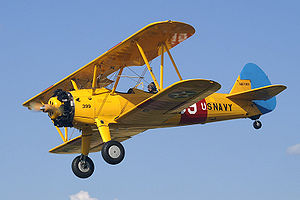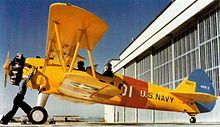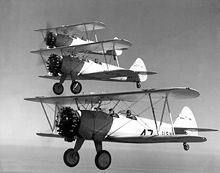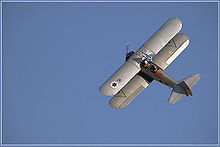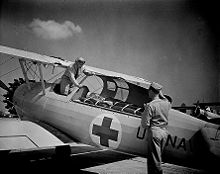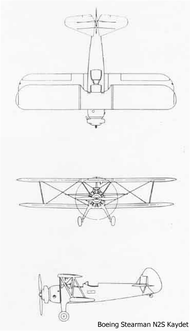- Boeing-Stearman Model 75
-
Model 75 "Stearman"
KaydetBoeing Stearman N67193 in USN markings Role Biplane Trainer Manufacturer Stearman Aircraft / Boeing Introduction 1934 Number built 9,800 Unit cost $11,000 The Stearman (Boeing) Model 75 is a biplane used as a military trainer aircraft, of which at least 9,783 were built in the United States during the 1930s and 1940s.[1] Stearman Aircraft became a subsidiary of Boeing in 1934. Widely known as the Stearman, Boeing Stearman or Kaydet, it served as a primary trainer for the USAAF, as a basic trainer for the USN (as the NS & N2S), and with the RCAF as the Kaydet throughout World War II. After the conflict was over, thousands of surplus aircraft were sold on the civil market. In the immediate post-war years they became popular as crop dusters and as sports planes.
Contents
Design and development
The Kaydet was a conventional biplane of rugged construction with large, fixed tailwheel undercarriage, and accommodation for the student and instructor in open cockpits in tandem. The radial engine was usually uncowled, although some Stearman operators choose to cowl the engine, most notably the Red Baron Stearman Squadron.
Distinctive sound
Because the design of the Stearman's propeller is unusual, reaching the speed of sound in normal operation, the sound of the plane stands out from other, similar aircraft, and is considered something of a trademark.
Operational history
Post-War usage
After World War II, the thousands of PT (primary trainer)-17 Stearmans were auctioned off to civilians and former pilots. Many were modified for cropdusting use, with a hopper for pesticide or fertilizer fitted in place of the front cockpit. Additional equipment included pumps, spray bars, and nozzles mounted below the lower wings. A popular approved modification to increase the maximum takeoff weight and climb performance involved fitting a larger Pratt & Whitney R-985 engine and a constant speed propeller.
Variants
The US Army Air Forces Kaydet had three different designations based on its power plant:
- PT-13, with a Lycoming R-680 engine. 2,141 total all models.[2]
-
- PT-13 Initial production. R-680-B4B engine. 26 built.
- PT-13A R-680-7 engine. 92 delivered 1937-38. Model A-75.
- PT-13B R-680-11 engine. 255 delivered 1939-40.
- PT-13C Six PT-13Bs modified for instrument flying.
- PT-13D PT-13As equipped with the R-680-17 engine. 353 delivered.
- PT-17 With a Continental R-670-5 engine. 3,519 delivered
-
- PT-17A 18 PT-17s were equipped with blind-flying instrumention.
- PT-17B Three PT-17s were equipped with agricultural spraying equipment for pest-control.
- PT-18
- PT-13 with a Jacobs R-755 engine, 150 built.
- PT-18A Six PT-18s fitted with blind-flying instrumention.
- PT-27
- Canadian PT-17. This designation was given to 300 aircraft supplied under Lend-Lease to the RCAF.
The US Navy had several versions including:
- NS
- Up to 61 delivered. powered by surplus 220 hp (164 kW) Wright J-5 Whirlwind.[3]
- N2S Known colloquially as the "Yellow Peril" from its overall-yellow paint scheme.
-
- N2S-1 R-670-14 engine. 250 delivered to the US Navy.
- N2S-2 R-680-8 engine. 125 delivered to the US Navy.
- N2S-3 R-670-4 engine. 1,875 delivered to the US Navy.
- N2S-4 99 US Army aircraft diverted to the US Navy, plus 577 new-build aircraft.
- N2S-5 R-680-17 engine. 1,450 delivered to the US Navy.
- Stearman 70
- (a.k.a. X70) The Wright Field XPT-943 based on the Stearman 6 Cloudboy.
- Stearman 73
- Civil production of the NS and PT-13.
- Stearman 75
- (a.k.a. X75) Evaluated by the army as a Primary trainer. The X75L3 became the PT-13 prototype. Variants of the 75 formed the PT-17 family.
- Stearman 76
- Export trainer and armed versions of the 75.
- Stearman 90 and 91
- (a.k.a. X90 & X91) Productionised metal framed version becoming the XBT-17.
- Stearman XPT-943
- The X70 evaluated at Wright Field.
- American Airmotive NA-75
- Single seat agricultural conversion of Model 75, fitted with new, high lift wings.[4]
Operators
 Argentina
Argentina- Argentine Navy
 Bolivia
Bolivia Brazil
Brazil Canada
Canada- Royal Canadian Air Force
 Taiwan
Taiwan- Republic of China Air Force
 Colombia
Colombia Cuba
Cuba Dominican Republic
Dominican Republic Greece
Greece Guatemala
Guatemala Honduras
Honduras Iran
Iran- Imperial Iranian Air Force
 Israel
Israel- Israeli Air Force
 Mexico
Mexico- Mexican Air Force
 Peru
Peru- Peruvian Air Force
 Philippines
Philippines- Philippine Army Air Corps
- Philippine Air Force
 United States
United States- US Army Air Corps/US Army Air Forces
- US Marine Corps
- United States Navy
 Venezuela
Venezuela
Survivors
A considerable number of Stearmans remain in flying condition throughout the world, as the type remains a popular sport plane and warbird.
- Brazil
- Israel
- The Israeli Air Force maintains a single airworthy PT-17 (31) at its museum in Hatzerim.
- Peru
- PT-17 on display Instituto de Estudios Históricos Aeroespaciales del Perú, Miraflores, Lima.
- Mexico
- 3 Pt-17 on the Air College for exibition
- United States
- PT-13D (s/n 42-17800) is on display at the National Museum of the United States Air Force in Dayton, Ohio. This aircraft is the last Kaydet produced. It was donated in 1959 by the Boeing Aircraft Company, which purchased the Stearman Company in 1938.[5]
- 75-3130 is on display in the hangar deck of the USS Yorktown (CV-10) at The Patriot's Point Naval and Maritime Museum in Charleston, South Carolina.
- A PT-17 in which George H.W. Bush once flew as part of his navy training is on display at the Pacific Aviation Museum, on Ford Island, Pearl Harbor.
- A PT-17 is on display Carolinas Aviation Museum, Charlotte, North Carolina.
- A PT-17 is on display at Vintage Flying Museum, Meacham International Airport, Fort Worth, Texas.
- A PT-17 is in regular use at Mississippi State University as a glider tow-plane[6]
Specifications (PT-17)
Data from United States Military Aircraft since 1909[7]
General characteristics
- Crew: two, student and instructor
- Length: 24 ft 9 in (7.54 m)
- Wingspan: 32 ft 2 in (9.81 m)
- Height: 9 ft 8 in (3 m)
- Wing area: 298 sq ft (27.7 m²)
- Empty weight: 1,931 lb (878 kg)
- Max takeoff weight: 2,635 lb (1,200 kg)
- Powerplant: 1 × Continental R-670-5 seven-cylinder air-cooled radial engine, 220 hp (164 kW)
Performance
- Maximum speed: 135 mph (117 knots, 217 km/h)
- Cruise speed: 96 mph (83 knots, 155 km/h)
- Service ceiling: 13,200 ft (4,024 m)
- Climb to 10,000 ft (3,330 m): 17.3 min
See also
- Aircraft of comparable role, configuration and era
- Arado Ar 66
- Bücker Bü 131 Jungmann
- De Havilland Tiger Moth
- Fleet Finch
- Focke-Wulf Fw 44 Stieglitz
- Gotha Go 145
- Naval Aircraft Factory N3N Canary
- Polikarpov Po-2
- PWS-26
References
Notes
- ^ National Museum of the United States Air Force gives the figure 10,346.
- ^ NMUSAF fact sheet: Stearman PT-13D Kaydet. Retrieved 18 May 2010.
- ^ Bowers 1989, pp.252-253.
- ^ Taylor 1965, p. 178.
- ^ United States Air Force Museum 1975, p. 21.
- ^ http://www.ae.msstate.edu/rfrl/pages/stearman.html
- ^ Swanborough and Bowers 1963, p. 443.
Bibliography
- Avis, Jim and Bowman, Martin. Stearman: A Pictorial History. Motorbooks, 1997. ISBN 0-76030-479-3.
- Bowers, Peter M. Boeing Aircraft since 1916. London:Putnam, 1989. ISBN 0-85177-804-6.
- Phillips, Edward H. Stearman Aircraft: A Detailed History . Specialty Press, 2006. ISBN 1-58007-087-6.
- Swanborough, F.G. and Peter M. Bowers. United States Military Aircraft since 1909. London:Putnam, 1963.
- Taylor, John W. R. Jane's All The World's Aircraft 1965–66. London: Sampson Low, Marston & Company, 1965.
- United States Air Force Museum. Wright-Patterson AFB, Ohio: Air Force Museum Foundation. 1975.
Videography
- Stearman, Lloyd. Stearmans, You Gotta Love Them. Lap Records, 2005. (NTSC Format)
External links
Stearman Aircraft Aircraft Companies Boeing model numbers Aircraft 1 · 2 · 3 · 4 · 5 · 6 · 6D · 6E · 7 · 8 · 10 · 15 · 16 · 21 · 40 · 42 · 50 · 53 · 54 · 55 · 58 · 63 · 64 · 66 · 67 · 68 · 69 · 72 · 74 · 75 · 77 · 80 · 81 · 83 · 89 · 93 · 95 · 96 · 99 · 100 · 101 · 102
200 · 202 · 203 · 204 · 205 · 214 · 215 · 218 · 221 · 222 · 223 · 226 · 227 · 234 · 235 · 236 · 246 · 247 · 248 · 251 · 256 · 264 · 266 · 267 · 273 · 281 · 294 · 299 · 300 · 306 · 307 · 314 · 316 · 344 · 345 · 367 · 367-80 · 377 · 400 · 450 · 451 · 464 · 474 · 701
707 · 717 (i) · 717 (ii) · 720 · 727 · 733 · 737 · 747 · 757 · 767 · 777 · 787 · 2707
Turbine engines 502 · 520 · 550
Vessels 929
USAAC/USAAF/USAF/Tri-service trainer aircraft Advanced Trainer Basic Combat Basic Trainer Primary Trainer (1924-1948) Trainer (1948-1990) "T-1", "T-2", "T-3" and "T-6" have also been assigned since 1962 in a separate sequence.USN/USMC trainer aircraft designations 1922-1948 Boeing NB • N2B
Curtiss (NC not assigned) • N2C
Piper Huff-Daland Howard North American Keystone Langley Martin (NM not assigned) • N2M
Naval Aircraft Factory Spartan NP
Fairchild Ryan Stearman NS • N2S
New Standard Timm Consolidated Lists relating to aviation General Aircraft (manufacturers) · Aircraft engines (manufacturers) · Airlines (defunct) · Airports · Civil authorities · Museums · Registration prefixes · Rotorcraft (manufacturers) · TimelineMilitary Accidents/incidents Records Categories:- United States military trainer aircraft 1930–1939
- Boeing aircraft
- Stearman aircraft
- Single-engine aircraft
Wikimedia Foundation. 2010.

